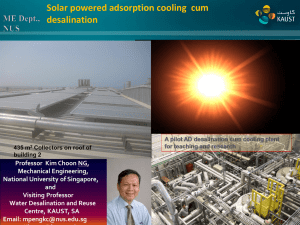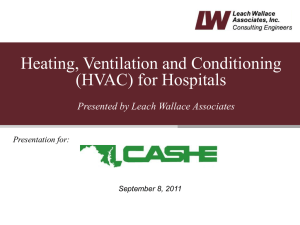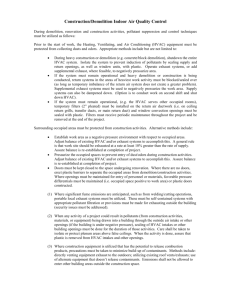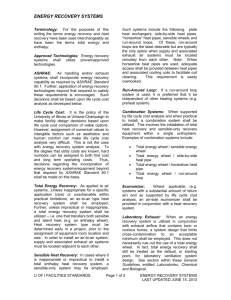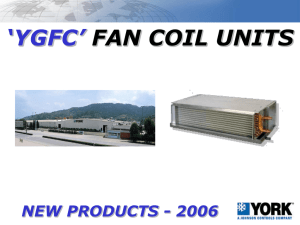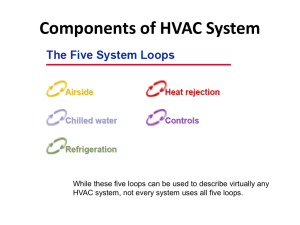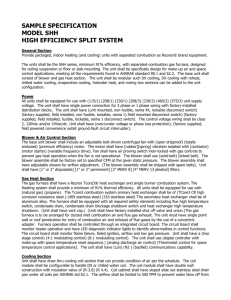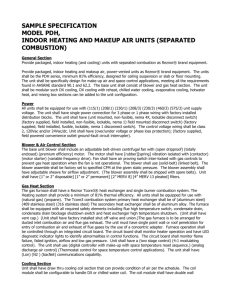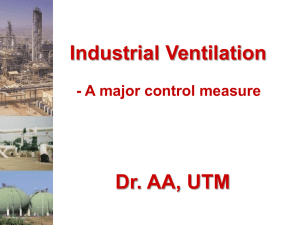Heat Recovery for Commercial Buildings
advertisement
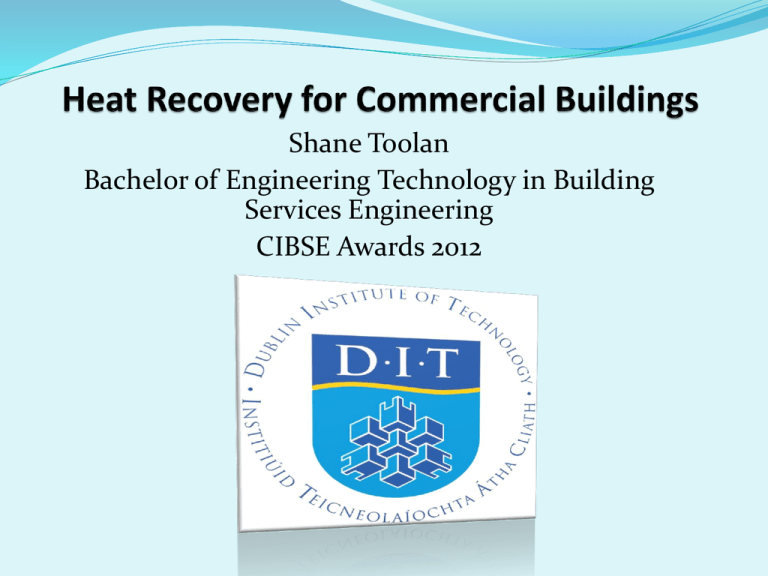
Shane Toolan Bachelor of Engineering Technology in Building Services Engineering CIBSE Awards 2012 Overview Commercial Buildings Heat Recovery Systems Heat Recovery Applications Case Study:- Simulation for clean room Heat Recovery- Why?? Many commercial buildings will require some form of air conditioning. Once the need for A/C is established, the engineer must incorporate any possible energy saving techniques into the design. One of these techniques is Heat recovery. We will examine devices that recover heat from exhaust ductwork. Features of a Thermal Wheel Recovers heat from exhaust air & transfers this heat to the supply air. Recovers both sensible and latent heat. High efficiencies ranging between 70 & 90%. RA – Pre recovery EA -After recovery OA –Pre recovery SA –After Recovery Thermal Wheel Continued. Manufactures catalogues give the required air velocity depending on the units size. One disadvantage is cross contamination of the two air streams. Harmful bacteria in the exhaust air can contaminate the supply air. A purge sector can be used to prevent the transfer of contaminants into the supply air stream. Features of a Run Around Coil (RAC) The RAC consists of a pair of finned tube coils which recover warm/cool air from the exhaust air stream. The pipe work system usually distributes water, which transfers the heat between the two air streams. A pump is fitted to circulate the water. Operate at an efficiency of between 40 & 60 %. Recovers sensible heat only. Return air temp = 24°C Supply air temp = 30°C Outside air temp = -1.9°C SAT after HR = 10.6°C Features of a Plate Heat Recuperator Cross flow heat exchanger. One of the simplest forms of equipment used for heat recovery. Efficiencies range between 50 & 70%. Conduction, which is a mode of energy transfer between two bodies of matter, transfers energy through the separating plates in the heat exchanger. Filters are easy to remove and clean for maintenance. Plate Heat Recuperator continued. The two air streams are directed in cross or counter-flow through the casing from the passages carrying the supply & exhaust air. Condensation can occur in certain weather conditions, therefore, a drip tray must be provided and connected to a drain. Separating plates usually comprise of metal, this eliminates moisture transfer. Winter process. A Study into the energy saving potential of a plate heat recuperator Loads are shown for an open plan office. Mass flow rate of air m = 7.41kg/s. The OAC, RAC, SAT are plotted on the psychometric chart. The recuperator has an efficiency of 70%. The cooling coil load is calculated using the formula Qcc = m(Δh)..kW. Cooling Coil load without HR = 7.41x (68.5-27.5) = 304 kW. Cooling Coil load with HR = 7.41 x (55.5-27.5) = 207.5 kW. The energy improvement with heat recovery was 97kW representing a 32% reduction on the cooling coil load. Example 1 – Psychometric Analysis Cleanrooms Cleanrooms use a considerable amount of energy compared to a traditional air conditioning system. The possible savings in costs and CO2 emissions will be examined. Close control of the working environment is required, air borne particles and chemical vapours must be kept to a minimum, leading to high air change rates of between 60 – 120 air changes per hour. Classified in terms of the size and number of particles permitted in terms of units of air volume. The work carried out in the space will dictate the classification of the cleanroom. With air flow rates so high, a heat recovery system would significantly reduce the load on the heating/cooling plant in the make up air handling units (MAU). Case Study For the case study, I reviewed research of a modelling and simulation study of a cleanroom carried out by K. Kircher. One method explored by Kircher in the case study was the introduction of a heat recovery system. The study focused on a 6600m2 nanoscience facility, containing a 1600m2 cleanroom. The facility had an energy budget of $1.8 million in 2008. Energy Consumption The primary sources of energy reviewed were:- electricity, steam, and chilled water . The cleanroom uses approximately 55% of the chilled water for the whole building. TRNSYS® simulation software is used to carry out the detailed HVAC calculations. The improvements to the HVAC system are analysed in this case study. Below is a schematic of the current HVAC system serving the clean room. Exhaust air which carries some of the preconditioned air and heated air from fume hoods is wasted without heat recovery. Case study continued Kircher proposed the installation of a heat recovery system with an effective area of 45m2. The savings were substantial, $110,700 was saved with the introduction of a heat recovery system. The heat recovery system alone reduced this cost by 6%. The payback periods for the proposed heat recovery system were two years and eight months for a new build, and four years and four months for a retro-fit. Conclusions Heat recovery for air conditioning systems reduces both energy consumption and CO2 emissions. Results showed that the heating/cooling capacity was improved by up to 48%. Co2 emissions dropped an average of 28%. As a process for reducing energy requirements, heat recovery is a tool that every engineer should use during design. Thank You
